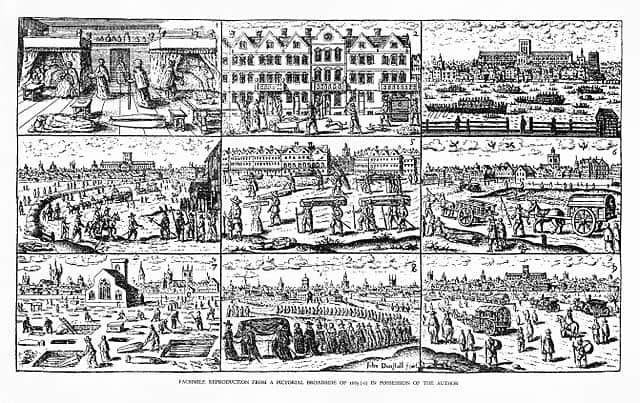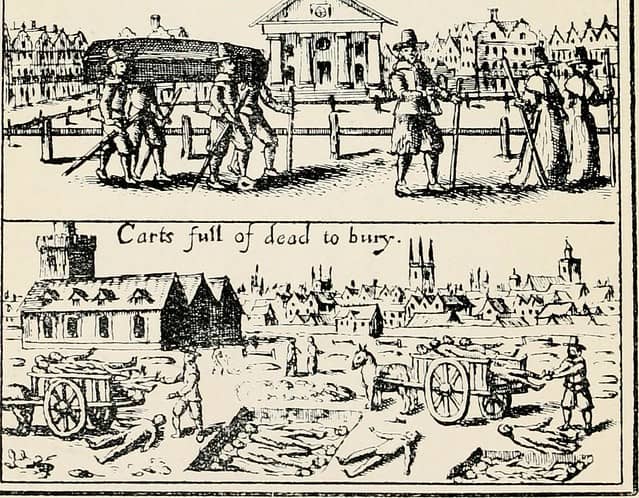Top 10 Disturbing Facts about the Great Plague of London
Over the years, London has fallen victim to several outbreaks of the plague. The Great Plague of 1665 was actually an outbreak of the bubonic plague, the same disease that killed thousands in England in the 14th century, known as the Black Death.
If you want to learn even more creepy facts about the Great Plague of London, keep reading!
1. This wasn’t the first time plague hit London

Plaque in the English sea port of Weymouth (Dorset at the time of the Black Death) by Les Haines – Flickr
In 1358, the Black Death hit London for the first time. It was carried over from Asia by rats on trading ships (more on this later). This was only the first strain of the disease. The second strain was passed on from humans to humans through airborne bacteria.
It’s hard to say how many people died from the Black Death in England due to poor census records. But, some records show that up to 30% of the English population was wiped out after all was said and done.
The plague returned to England and London in particular several other times between 1358 and 1665. Notably, in 1563, when it wiped out nearly 25% of London’s population.
2. Rats brought the plague to London
As with the Black Death, the Great Plague was brought to London via rats on trading ships coming from Asia. It was the same disease as the last time, the bubonic plague.
Since the Black Death, the plague was an understandable fear in the lives of Londoners. While none had seen the damage that the Black Death brought, there were stories and even “plague laws” put in place in the hopes of stopping another spread.
One, which we’re familiar with today, is the idea of quarantine. If someone was suspected of having the plague, they were forced to stay inside for 40 days. The Italian word for forty days is quarantina, and the anglicized version of the word stuck.
3. The Great Plague only lasted for 18 months
The effect of the Great Plague of 1665 on Europe and England was nowhere near the levels of the Black Death, but something that is quite shocking is that over just 18 months, 200,000 Londoners perished.
This time around the plague affected London much more directly than the Black Death. 200,000 was a huge portion of the population at the time.
The worst week of the plague occurred from September 19-26, 1665, with 7,165 deaths recorded in London.
4. London was a medieval city at the time
Not only was London a medieval city at the time, but it was also extremely crowded and unsanitary. The sections of the city near the port area were separated from the nicer suburbs by a wall, and the poor and working-class were forced to live in filth.
Workers and their families lived in crowded tenement housing and there was sewage in the streets. It’s no wonder that this area was also teeming with rats, those pesky animals that caused the plague to spread quickly in the first place.
5. Poor Londoners were stuck in the city

Two women lying dead in a London street during the Great Plague, 1665 by Robert Pollard – WikiCommons
The rich and noble of London were able to escape from the city fairly easily when the plague broke out in 1665. These richer families had large homes in the countryside that was free from the disease so it shouldn’t be surprising that they wanted to leave London as soon as they could.
Eventually, checkpoints were set up at the entrance to the city wall, and you were required to have a certificate of good health in order to leave. These certificates were to be written and signed by the Lord Mayor of the city, and as you can imagine quickly became hard to come by.
6. If you had the plague, a red cross was painted on your door

A street during the Great Plague in London with a door with a red cross by Edmund Evans – WikiCommons
As I already mentioned, if you were suspected of having the plague, you were required to stay inside your home for 40 days. This also applied to any family members or domestic staff that lived in the same house as you!
As a way of warning others of your, erm, condition, a red cross was painted on your door. The words, “Lord have mercy upon us” were also painted, and a watchman was placed outside your door in order to make sure that no left the premises.
7. Many animals were killed

Two men discovering a dead woman in the street during the Great Plague of London by J. Jellicoe after H. Railton – WikiCommons
Thousands of dogs and cats were killed in London during the Great Plague. At the time, no one really understood where the plague came from. There were theories that it spread through rats, but there were other ideas.
One rumor was that the plague was being spread by cats and dogs. When the Lord Mayor got word, he ordered that all cats and dogs be killed. It is estimated that 200,000 cats and 40,000 dogs were killed as a result. Unfortunately, the Lord Mayor got things all wrong. Dogs and cats were actually helping to keep the plague at bay, as they helped to keep the rat population down.
8. Doctors at the time didn’t know how to treat the plague

A dying man in bed is surrounded by onlookers and demons by Karel van Mallery after Jan van der Straet – WikiCommons
As you can imagine, health care of the 17th century wasn’t nearly as sophisticated as today. As the plague was spread by bacteria, and England was centuries away from discovering antibiotics, any type of treatment could be considered pointless.
Doctors tried many different ways of treating the plague, like sweating, forced vomiting, and bloodletting. Some officials believed that smoke could help cure the disease, and large bonfires were constructed all over the city. None of these methods worked to cure victims of the plague.
9. Death by the plague was not a pretty way to go
As I began doing the research for this article, I stumbled across some pretty gnarly photos of the plague. Trust me, you guys wouldn’t want to have suffered from this disease.
The plague attacked the lymph nodes of its victims and caused large swells called “buboes” to emerge all over the body. Coughing up blood, headaches, fever, vomiting, and blisters were other symptoms of the disease.
10. Bodies were required to be buried at night
As the plague continued to ravage London, graveyards quickly became full. At one point, people would wander the streets of the city shouting, “Bring out your dead!” while pushing a cart. Those with bodies to bury would, well, bring out their dead and place them in the carts. The bodies were then brought to a mass grave.
City officials soon began to realize that this was causing panic in the streets and decreed that all burials needed to take place at night. Nonetheless, bodies began to pile up in the streets of London. Nighttime burials may have helped slightly, but it didn’t change the fact that thousands of Londoners were dying.
Conclusion
I don’t think anyone can truly imagine what it was like to live in London during the Great Plague of 1665. And, I don’t think that anyone would want to go back in time to see it!
I hope that you’ve enjoyed learning more about what it was like in London during the Great Plague. If you’d like to learn more about the history of England’s capital, why not join one of our walking tours? Our local guides are sure to impress with their expertise. Click here to learn more and make your booking!
Planning a trip to Paris ? Get ready !
These are Amazon’s best-selling travel products that you may need for coming to Paris.
Bookstore
- The best travel book : Rick Steves – Paris 2023 – Learn more here
- Fodor’s Paris 2024 – Learn more here
Travel Gear
- Venture Pal Lightweight Backpack – Learn more here
- Samsonite Winfield 2 28″ Luggage – Learn more here
- Swig Savvy’s Stainless Steel Insulated Water Bottle – Learn more here
Check Amazon’s best-seller list for the most popular travel accessories. We sometimes read this list just to find out what new travel products people are buying.















